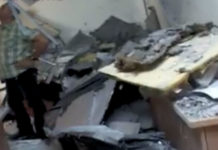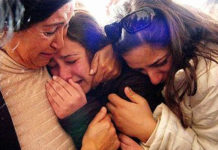A renowned Israeli photojournalist and director of the Sderot Media Center in Israel spoke at the GW Hillel Friday night during Shabbat dinner to raise awareness about the ongoing violence in Israel’s Negev region and to present a human face to the news.
Noam Bedein, a resident of Sderot, is touring colleges to give presentations that draw on his personal experiences as well as photographs and video footage he has compiled.
He said his goal is to not only shed light on the subject of the ongoing rocket attacks in the Negev region – a subject he feels is not getting enough coverage in the media – but also to go beyond the frequently reported statistics and show the effects of these attacks on a psychological and personal level.
“People here don’t know what’s happening in western Negev,” Bedein said. “Even in Israel, people do not even know what’s really happening. By me living there, I can give them the true story, the human story, of what’s really happening on a daily basis.”
While major media outlets often report casualties, Bedein insists that they do not paint a picture of the fear and intensity involved in the rush to a shelter after the warning siren sounds.
“The question is, how do you show psychological effects in the media?” Bedein asked, referencing the trauma that so many Sderot residents face on a daily basis.
For Bedein, the answer comes through speeches from those who have a first-hand account of the crisis in Sderot, along with videos and photographs, many of which he has posted on the Sderot Media Center Web site and YouTube.
“You can always talk, but until you really see and experience it, you won’t understand what I’m talking about,” he said.
To convey his message, the walls of the room in which he presented were lined with photographs of the violent region. Bedein gave first and second-hand accounts of the atrocities in the area.
Many of these stories dealt with the necessity for everyone in Sderot to live on edge in order to be prepared for rocket attacks. He described how people drive through the city with the radio off so they are able to hear the warning siren, and do not wear seatbelts so they can quickly get out of their vehicles and run towards shelter if necessary.
Bedein described the universal anxiety felt each time the sirens sound in Sderot, affecting everyone from people working in an office building who are forced to rush towards a staircase or windowless room, or school children running to a secure classroom.
“Once a rocket has been launched from Gaza towards Sderot, you’ve got 15 seconds to run for your life,” he said.
Bedein said one of his regrets is that there are thousands of different stories and personal accounts, but he does not have the time to tell all of them during each presentation.
“Noam highlights an aspect of Israeli society which you’re not hearing about in the mainstream now,” said sophomore Harry Baumgarten, president of the Student Association for Israel.
Most of the 60 or so people in attendance had at least a basic knowledge of the situation in Sderot, especially junior Benji Davis who has recently been volunteering in the Israeli region and working with the Sderot Media Center.
Still, Bedein said he believes that the majority of people, both in the United States and Israel, do not fully grasp the severity of the problem.
“The first step is getting people aware,” Bedein said. “People always have these creative solutions; what needs to be done and what Israel can do, but you can not get to any solutions if you do not understand the reality of what this town represents.”












